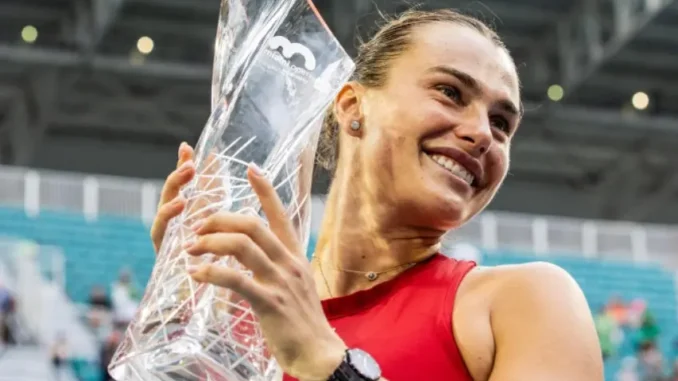
In the high-octane world of professional tennis, where every serve and volley can shift the tides of fate, Aryna Sabalenka stands as a towering figure—a Belarusian powerhouse whose journey to the top has been anything but ordinary. Now the world No. 1, Sabalenka has carved out a legacy with three Grand Slam singles titles and a reputation for ferocious baseline play that leaves opponents scrambling. But beneath the thunderous forehands and steely resolve lies a pivotal moment that redefined her career, a turning point she recently opened up about with a candor that’s as striking as her game. It’s a story of vulnerability, reinvention, and a serve that once threatened to unravel her dreams—only to become the cornerstone of her ascent.
Picture Sabalenka in the summer of 2022, slumped on the ground outside a stadium in Toronto, tears streaking her face. She’d just lost to Coco Gauff in a grueling three-set match at the National Bank Open, but it wasn’t the defeat that broke her—it was the 18 double faults she’d served up, a staggering tally that capped a week of serving woes. The day before, she’d notched 16 in a win; the week prior, 20 in a loss to Daria Kasatkina, and 23 in the match before that. Her serve, the shot that starts every point, had become a liability, a runaway train derailing her matches and her confidence. “I was crying, sitting on the ground,” she’s recalled, painting a vivid picture of despair. “It was a moment where I thought, ‘This can’t go on.’” For a player whose raw power had already propelled her to No. 2 in the world by 2021, this was the crisis that could’ve stalled her forever—or changed everything.
That breakdown in Toronto wasn’t just a low point—it was the spark. Sabalenka, then 24, refused to let her serve define her as a cautionary tale. She turned to her team, a tight-knit crew she calls family, and brought in a biomechanics expert to dissect and rebuild her motion. The serve, a biomechanical marvel that’s the only mandatory shot in tennis, had been her Achilles’ heel, gnawing at her psyche with every double fault. “It’s not just losing a point for free,” she’s explained, “it’s the way it gets into your head, your muscles, everything.” With her coach Anton Dubrov by her side—a former player who’d been her hitting partner before stepping into a bigger role—she overhauled the mechanics. They stripped it down, adjusted her toss, refined her rhythm, and turned a weakness into a weapon. “We worked so hard,” she’s said, her pride evident. “I had to trust the process, even when it felt like nothing was working.”
The results speak for themselves. By 2023, Sabalenka was a Grand Slam champion, clinching the Australian Open with a serve that no longer betrayed her under pressure. That victory in Melbourne, her second major after the 2022 US Open, was a testament to her reinvention—she dropped just one set en route to the title, her newfound consistency a stark contrast to the chaos of Toronto. “That moment in Canada, it was tough, but it made me stronger,” she’s reflected, tying that low to her highs. The 2024 season cemented her dominance: another Australian Open crown, a US Open triumph over Jessica Pegula, and a Miami Open title in 2025 that showcased her evolution. Her eight WTA 1000 titles, including back-to-back Madrid wins in 2021 and 2023, underline a career that’s soared since she faced her demons head-on.
But it’s not just about the trophies—it’s the mental shift. Sabalenka, once prone to emotional meltdowns, found a new gear in Toronto’s aftermath. She’d always been a fighter—“I do my best to fight to the end,” she’s said, a mantra born from gritty battles like her 2024 Roland Garros loss to Mirra Andreeva while battling illness. Yet, the serve saga taught her patience and precision, tools she now wields with finesse. Against Pegula in the 2024 US Open final, she didn’t just blast her way through; she mixed in drop shots and net play, a versatility honed through adversity. “I’m really glad I’m brave enough to use these tools in key moments,” she’s noted, a nod to the growth that’s made her a nightmare for rivals like Iga Świątek, whom she’s toppled to claim the No. 1 spot.
Sabalenka’s story is one of transformation, sparked by a single, shattering day in 2022. From a player haunted by double faults to the world’s best, she’s turned a career-defining flaw into a symbol of resilience. With 19 singles titles and a net worth pushing $18.7 million, she’s not just surviving—she’s thriving. “It damaged me, but it also saved me,” she’s hinted about that Toronto moment, a confession that reveals the heart of a champion who refused to let her own power break her. As she eyes more majors, Sabalenka stands as proof that sometimes, the key to everything lies in hitting rock bottom—and swinging back harder than ever.
Leave a Reply